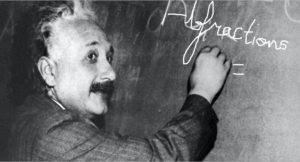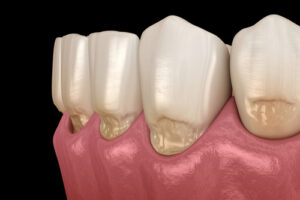Dental Monthly
Do you know what abfraction is?
Don’t worry I am sure even Albert could figure that one out…

And the thing is he probably had it too, like many of us.
It sounds like some kind of nuclear reaction, like the splitting of a Neutron, but it is just a non-carious cervical lesion of the teeth. Maybe it is still a bit vague, so to describe it clearly: it is a wedge shaped lack of tooth structure without any decay, at the neck of your tooth bordering the gums. As I said, the wedge-shaped or V-shaped damage is unrelated to decay, bacteria, or infection.
So the question arises:
1/What are abfractions caused by?
Abfraction is caused by stress and pressure applied to the teeth through biting, chewing, clenching teeth, and most commonly, teeth grinding. These forces put great stress on the teeth near the gum line at the neck of the tooth. I would like you to think of a bridge over water with heavy traffic: Where does the bridge start to deteriorate and loose pieces of cement or show deep cracks? At the water level. I like to give this example because water, among other things, erodes too, which makes the picture complete. Usually, people are not aware of this damage, especially if they are also unaware of their clenching parafunctions. In time the destructive power of an imperceptible, but constant force creates this axe-like cut in your tooth. Now wait a minute! My teeth are made of the hardest tissue in my body, so….

2/Why can’t teeth handle some chewing?
Good question! Teeth are indeed the hardest tissue and can easily bear the forces, the chewing muscles (80-100kg / mm2) can exercise. But there is more going on. Not all chewing and clenching (a) is believed to lead to abfraction. Normal, properly aligned teeth are less likely to develop abfraction. However, when they are misaligned called malocclusion (b), some teeth receive more of the stress from biting and chewing than others.This can occur in combination with pathological wear (c), such as abrasion and erosion caused by acids and erroneous brushing habits. This helps to explain why some individuals exhibit more than one type of cervical wear mechanisms than others.
3/How do I know I have an abfraction in my tooth?
Usually your dentist informs you, but if, like Albert, you want to figure it out by yourself, you can check your own teeth. It is easy to recognize, because it looks as if, like in a tree, two sharp cuts have been made and a wedge shaped piece is missing near your gums. Usually, you can sense it with a finger nail that will stick to it. I see abfraction more often in people with short square faces, who have very powerful muscles in the cheeks and much less in long or oval faced people.
4/What are the Dangers of Abfraction
Abfraction is dangerous to oral health because it causes permanent damage to the neck of a tooth. This increases the risk of caries-cavities, because it leaves the inner structures of the tooth vulnerable to decay and bacteria, which causes gum inflammation and gum recessions. If left untreated, abfraction ultimately leads to nerve infections, severe decay, and even tooth fracture and loss.
5/Treatment for Abfraction
At Studio Moll we put together a personalized treatment plan depending on what the dominant cause is. There may be hypersensitivity of severely compromised teeth, aesthetic reasons or danger of fracture.
A/ To resolve the damage of abfraction, we use restorative composite resin tooth-coloured fillings which have proved to be beneficial by restoring lost areas of the teeth. We use the minimally invasive no-pain Laser, also because of its capacity to contemporarily remodel the gums without any bleeding. Especially if sensitivity has developed due to exposure of the inner tooth neck.After careful evaluation we might need to integrate this treatment with Periodontal Plastic surgery if there is a severe loss of gums.
B/To resolve the causes, we correct and align teeth when abfraction is caused by malocclusion. Treatment with Invisalign aligners is the best option as they prevent bruxism and clenching at the same time.
C/Those who have developed abfraction lesions as a result of chronic teeth grinding are helped with nightly use of a mouth guard.
If you have or suspect you have abfractions you can reach out to Studio Moll for a check-up.
Call 055-755347 for your appointment.
BIO

For any questions, you can contact Studio Moll
Whatsapp: 331-6368628, or tel: 055-755347
For more information, look up Studio Moll’s YouTube channel and here too.
By Dr. Elena Speranza Moll
Studio Moll
Via Amilcare Ponchielli 21B, 50018 Scandicci –Firenze
Tel: 055-755347
WhatsApp: 331-6362682
Follow me on Youtube

